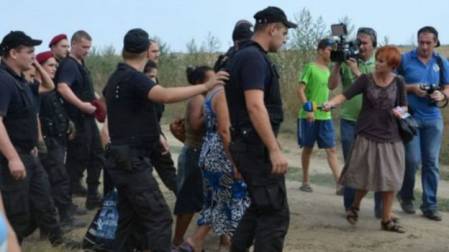Terrifying Precedent Set by Authorities’ Response to Violent Anti-Roma Pogrom

Disturbances on August 27 in Loshchynivka (Odesa oblast) have resulted in the targeted ethnic group ‘agreeing’ to leave the area, and being too fearful to even return to collect their possessions. There are differences from the pogroms of the past, but there are also some very worrying similarities, including how the authorities and law enforcement bodies reacted.
Tragically the first difference is that a child really was murdered. The 9-year-old girl’s body was found in an abandoned building near to where she lived on Saturday morning. She had been murdered, and the police are saying that there are also signs that she was raped. Since the chief suspect has now retracted any testimony given originally and denies guilt, the results of the forensic investigation are now urgently awaited. There are a number of discrepancies in the reports about the murder, and the case against the suspect appears to rely on the testiomy of the murdered child’s small brother. The police assert that there is other compelling evidence against the man in custody, a 21-year-old man, but provide no details. On Monday the court detention hearing was held, at the request of the prosecutor, behind closed doors, which under the circumstances seems undesirable
The suspect knew the family and occasionally drank with the little girl’s stepfather. He is from a mixed family, and is not part of the Roma community. He has himself lived in Loshchynivka all his life which is important to note, since those locals who used the arrest of a young Roma man as pretext for a pogrom claimed that there was now a problem because of Roma who had arrived in the last 3 years. Others told the Odesa website Dumskaya that they had targeted those who had not been there long.
Disturbances began during the day on August 27 with around 300 people smashing up a number of homes where Roma families were living. The fact that nobody was hurt seems to be only because the people in those houses had already fled.
The police present were heavily outnumbered, nonetheless the video footage of them standing, effectively just watching the destruction, is disturbing.
It took intervention from the local authorities and a promise to hold negotiations the following day, before the crowd stopped their destruction. By then around 10 houses had been smashed up. Three were owned by the people in them, the others were rented. Dumskaya notes that the three homes of more affluent Roma were not targeted.
By Sunday morning, a special force unit was present patrolling the village. The Village Mayor Viktor Paskalov and Head of the Izmail District Administration Valentina Stoikova and others met with over 200 residents who demanded ‘the removal’ of the Roma living there.
The situation was certainly highly volatile. During the meeting, a rumour went about that the residents in question were returning. The crowd charged off to ‘catch’ them, and found three doubtless terrified women trying to hide in some bushes. Police intervention was needed, and thankfully forthcoming, to keep the women safe.
It seems likely that the local authorities rather sided with the pogrom initiators, while the police simply wanted to avoid further disturbances.
After talks with the local Roma community, the latter ‘agreed to voluntarily leave’ Loshchynivka, on condition that a safe corridor and transport were provided on Monday morning for them to return and take away their possessions. It is likely that the treatment of the three women on Sunday deterred others, and on Monday morning nobody wanted to return to collect things. It was later reported that women and children had nonetheless arrived to collect belongings from one home.
No information was revealed as to how the Roma residents had been persuaded “to agree” to leave, with this being after Stoikova herself acknowledged that a ‘decision’ apparently taken by the Village Council had no legal weight. Threatening to not provide the protection to which they were certainly entitled would already have been a compelling reason.
One of the most active local publications covering the events was Bessarabia Inform. The site’s language regarding the disturbances and their cause is alarmingly inflammatory.
The situation is deeply disturbing and requires adequate response. A young man from Loshchynivka may or may not have committed a terrible crime. That could not under any circumstances be grounds for targeting the entire ethnic group that he belongs to. The news that a formal criminal investigation into the pogroms is hardly sufficient response, given that the local authorities have effectively provided exactly what the mob was demanding.
That is a terrifying precedent.





